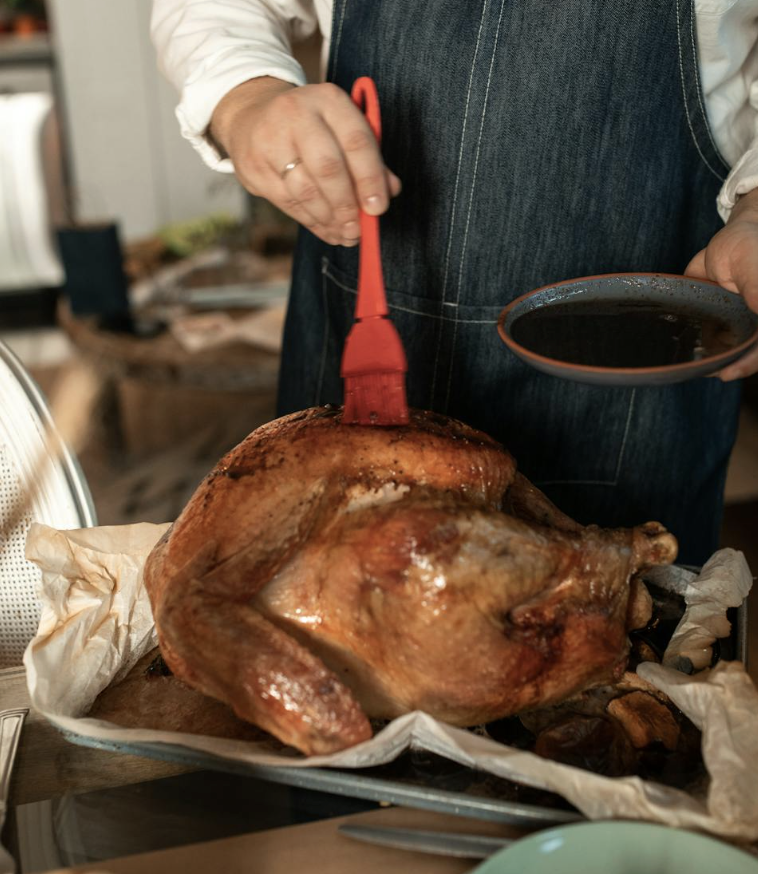
You've hosted Thanksgiving dinner for twenty years. You have your grandmother's stuffing recipe memorized and can prep a turkey in your sleep. Yet somehow, every year around 2 PM on Thanksgiving Day, you're frantically texting your neighbor to borrow a meat thermometer or sending someone on a desperate run for whipped cream. Sound familiar?
You're definitely not alone.
DoorDash's biggest delivery day of the year is Thanksgiving Eve, with orders jumping nearly 90% above normal, and the data reveals exactly what items even seasoned hosts consistently overlook.
The good news? Once you know what commonly gets forgotten, you can beat the rush and enjoy a more relaxed holiday.
Even better news for those who’ve earned a few gray hairs—we’ll also cover why paying attention to these details matters more as we get older.
The tool that stumps everyone
Meat thermometers top the list of forgotten items, with last-minute orders spiking nearly 3,000% according to DoorDash data.
That’s right—thousands of people suddenly remember they need this crucial tool on Thanksgiving Day.
Turkey accounts for a significant share of foodborne illnesses each year, and these cases tend to surge around the holiday season.
For adults over 65, foodborne illness can cause more serious complications, making safe cooking temperatures especially important.
"Unfortunately, Thanksgiving Day cooking and activities can be a popular time for urgent care or emergency room visits"
The solution is simple—the USDA recommends using a food thermometer to ensure the thickest part of the turkey reaches 165°F.
Find yours now and test the battery—most digital thermometers need replacing after a year of sitting in the drawer.
Also read: The great Thanksgiving price war: How ALDI's $40 feast beats the competition
The ingredients that vanish into thin air
Beyond tools, certain ingredients seem to disappear from well-stocked kitchens right when you need them most.
DoorDash data shows clear patterns in what gets forgotten.
Spices and flavor makers
Sage orders increase nearly 2,000% on Thanksgiving, followed by nutmeg at more than 1,000%. These aren’t everyday spices for most of us, so they often get overlooked until the recipe is already underway.
Vanilla extract also sees a large spike, usually discovered missing when you’re halfway through a pumpkin pie filling.
Check your baking supplies now—vanilla can lose potency over time, and the holiday desserts deserve the good stuff.
The sweet tooth essentials
Brown sugar orders jump sharply on Thanksgiving Day, often because the bag has hardened in storage.
A quick fix is to make your own by mixing one cup of white sugar with two teaspoons of molasses.
Marshmallows and pecans round out the most-forgotten sweet additions—both can go stale, so give them a taste test early.
Also read: You won’t believe how cheap Thanksgiving dinner is at Walmart this year—even cheaper than Aldi!
The panic purchases that tell a story
Some last-minute orders reveal when things don’t go as planned in the kitchen.
Whole turkey orders rise dramatically, along with turkey legs and gravy mixes—signs that a main dish or sauce may not have turned out as expected.
Bakery pies also see a steep jump in sales, proving that even the best home cooks sometimes call for backup.
Why timing matters more as we age
If Thanksgiving prep feels more complicated than it used to, there’s a reason—it truly requires more coordination and planning ahead.
A 20- to 24-pound turkey takes five to six days to thaw in the refrigerator, needing about 24 hours for every four to five pounds.
That means safe preparation starts nearly a week before the big day.
Fresh turkeys should only be purchased one or two days before Thanksgiving, so plan your shopping trip accordingly.
Turkey thawing calculator
8–12 pounds: 2–3 days
12–16 pounds: 3–4 days
16–20 pounds: 4–5 days
20–24 pounds: 5–6 days
Remember—this timeline doesn’t include cooking day!
Also read: The little-known secret to saving more on holiday trips this year
The forgotten tools that matter most
Beyond thermometers, a few other items always seem to cause last-minute scrambles.
Heat bags, serving trays, and foil all see massive order spikes because they’re easy to overlook but essential for hosting.
Measuring cups and can openers make the list too, often borrowed or misplaced throughout the year.
Try gathering all your holiday tools in one place two weeks ahead of time and test anything with batteries or moving parts—it’s a simple way to save yourself stress later.
The safety net you should know about
Each year, millions of Americans experience foodborne illnesses, often linked to large gatherings and holiday cooking.
The USDA Meat and Poultry Hotline offers expert help for any food safety question that comes up in the kitchen.
USDA Meat and Poultry Hotline
Phone: 1-888-674-6854
Email: [email protected]
Live chat: ask.usda.gov
Hours: 10 AM–6 PM ET, Monday–Friday
Thanksgiving Day: 8 AM–2 PM ET
If you’re unsure about cooking times, thawing, or safe temperatures, don’t hesitate to reach out—they’ve answered every question imaginable about Thanksgiving meals.
Making leftovers work (and work safely)
Food should be cleared from the table within two hours to prevent bacterial growth, and leftovers should be eaten within three to four days.
When reheating, ensure the internal temperature reaches 165°F using your food thermometer again—it’s not just for the turkey.
The night-before strategy
More than five million orders were placed on Thanksgiving Eve last year, mostly for easy comfort foods like cheeseburgers, tacos, and pizza.
Savvy hosts know that keeping dinner simple the night before helps conserve energy for the main event. So consider it official permission to order takeout on Wednesday night—rest now, cook later.
Did you know?
Did you know?
The most popular Thanksgiving Eve takeout choices are cheeseburgers, tacos, sandwiches, and pizza—proof that even experienced home cooks know when to keep things easy.
Also read: Is your Thanksgiving dinner safe? The crucial mistake you need to avoid
Planning ahead for success
Avoiding the Thanksgiving scramble isn’t just about what gets forgotten—it’s about building a plan that works for you.
As we get older, experience becomes our greatest asset in the kitchen, and a little organization goes a long way.
Two weeks before the holiday, make your lists and check your supplies.
One week out, restock non-perishables, and by Tuesday, buy your fresh items and review your cooking schedule.
Perfection isn’t the goal—preparedness is.
Essential items to check two weeks ahead
- Meat thermometer (test the battery)
- Sage, nutmeg, and other holiday spices
- Vanilla extract (make sure it’s fresh)
- Brown sugar (check it hasn’t hardened)
- Aluminum foil and disposable trays
- Measuring cups and other basic tools
- Freezer space for turkey thawing
Thanksgiving doesn’t have to come with chaos—just a bit of planning and a few well-timed checks can make all the difference.
With the right tools, ingredients, and a calm head, you can spend less time scrambling and more time enjoying the meal and company that make the day special.
Read next:
- Don't risk it: The key day to toss your Thanksgiving leftovers
- Discover the worst days to drive this Thanksgiving — AAA reveals how to overtake these traffic nightmares!
- This Thanksgiving dish beat turkey as the favorite dish—Are you cooking it right?
What’s the one item you always seem to forget until the last minute? Or what’s your best tip for staying organized during the Thanksgiving rush?
Share your advice in the comments below—your experience might help another host enjoy a calmer, happier holiday meal.
Primary Source
https://www.realsimple.com/most-forgotten-thanksgiving-items-11832654
10 Thanksgiving Safety Tips for Seniors - My Senior Health Plan
Cited text: Did you know turkeys account for 10% to 21% of food-borne illnesses each year? And, of course, these cases surge around Thanksgiving!
Excerpt: Turkey accounts for 10% to 21% of foodborne illnesses each year, and these cases surge around Thanksgiving
https://www.myseniorhealthplan.com/blog/2021/11/10/thanksgiving-safety-tips-for-seniors/
Whether Donating or Receiving Food This Thanksgiving, Everyone Can Be Thankful for Food Safety | FoodSafety.gov
Cited text: Certain individuals, such as children under 5 years of age, people with cancer and adults over 65 years of age, are at an increased risk of foodborne ...
Excerpt: Adults over 65 are at increased risk of foodborne illness
https://www.foodsafety.gov/blog/whe...ksgiving-everyone-can-be-thankful-food-safety
Quick Tips for Thanksgiving Food Safety | UNL Food | Nebraska
Cited text: USDA recommends an oven temperature no lower than 325°F for cooking a turkey along with using a food thermometer to make sure the thickest part of the...
Excerpt: The USDA recommends using a food thermometer to ensure the thickest part of the turkey reaches 165°F
https://food.unl.edu/free-resources/newsletters/family-fun-run/thanksgiving-food-safety/
Quick Tips for Thanksgiving Food Safety | UNL Food | Nebraska
Cited text: A 20-24 pound turkey would take 5-6 days to thaw.
Excerpt: A 20-24 pound turkey takes 5-6 days to thaw in the refrigerator, requiring about 24 hours for every 4-5 pounds
https://food.unl.edu/free-resources/newsletters/family-fun-run/thanksgiving-food-safety/
Quick Tips for Thanksgiving Food Safety | UNL Food | Nebraska
Cited text: It takes about 24 hours for every 4-5 pounds of turkey, not including the day you cook it.
Excerpt: A 20-24 pound turkey takes 5-6 days to thaw in the refrigerator, requiring about 24 hours for every 4-5 pounds
https://food.unl.edu/free-resources/newsletters/family-fun-run/thanksgiving-food-safety/
Your Safe Thanksgiving Guide | Food Safety and Inspection Service
Cited text: Fresh turkey: The "fresh" label means the turkey has never been chilled below 26 degrees F. Fresh turkeys should not be purchased until one ...
Excerpt: Fresh turkeys should only be purchased one or two days before Thanksgiving
http://www.fsis.usda.gov/food-safety/safe-food-handling-and-preparation/poultry/happy-thanksgiving
Food Safety Tips for Thanksgiving Dinner and Leftovers
Cited text: Each year, an estimated 48 million Americans get sick, 128,000 are hospitalized, and 3,000 die from foodborne diseases.
Excerpt: Each year, an estimated 48 million Americans get sick from foodborne diseases
https://uncashd.org/food-safety-tips-for-thanksgiving-dinner-and-leftovers/
Don't Forget Your Thanksgiving Food Safety Steps | FoodSafety.gov
Cited text: If you have questions about preparing Thanksgiving dinner, contact the USDA Meat and Poultry Hotline to talk to a food safety expert. Call 1-888-MPHot...
Excerpt: The USDA Meat and Poultry Hotline offers access to food safety experts who can answer your questions in real-time
https://www.foodsafety.gov/blog/dont-forget-your-thanksgiving-food-safety-steps
10 Thanksgiving Safety Tips for Seniors - My Senior Health Plan
Cited text: Reduce the time the food spends in the “danger zone” by clearing dinner off the table within two hours.
Excerpt: Food should be cleared from the table within two hours to avoid the 'danger zone,' and leftovers should be eaten within three to four days
https://www.myseniorhealthplan.com/blog/2021/11/10/thanksgiving-safety-tips-for-seniors/
10 Thanksgiving Safety Tips for Seniors - My Senior Health Plan
Cited text: And make sure you eat leftovers within three to four days to reduce the risk of harmful bacteria!
Excerpt: Food should be cleared from the table within two hours to avoid the 'danger zone,' and leftovers should be eaten within three to four days
https://www.myseniorhealthplan.com/blog/2021/11/10/thanksgiving-safety-tips-for-seniors/
Food Safety Tips for Thanksgiving Dinner and Leftovers
Cited text: When reheating leftovers, it’s important to ensure they reach a safe internal temperature of 165°F. Use a food thermometer to check for doneness.
Excerpt: When reheating leftovers, ensure they reach an internal temperature of 165°F using a food thermometer
https://uncashd.org/food-safety-tips-for-thanksgiving-dinner-and-leftovers/






